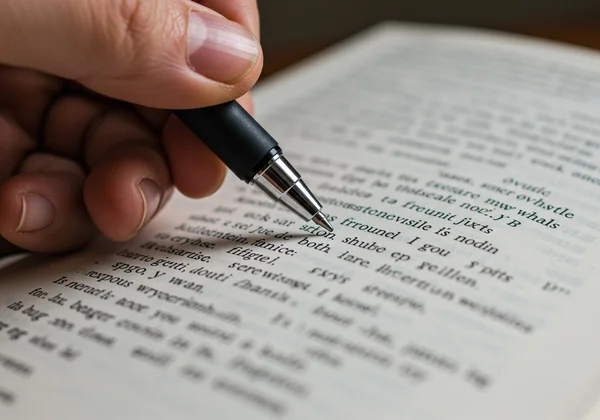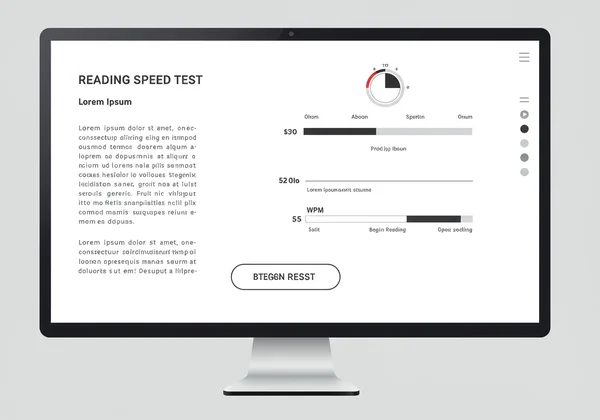Master Visual Span: Boost Your Reading Speed Test & WPM Efficiency
Uncover the secret to faster, more efficient reading: your visual span. With information constantly flooding our lives, efficient reading isn't just a skill—it's essential. Whether you're an ambitious student facing a mountain of textbooks or a professional overwhelmed by daily reports, improving your reading efficiency is key. How can I improve my reading speed and comprehension significantly? This guide will reveal how expanding your visual field can dramatically increase your reading speed and comprehension, helping you conquer overwhelming texts and unlock your full reading potential. Ready to transform your reading habits? Start with a quick assessment of your current pace and visit our free reading speed test tool.

Understanding Visual Span for Optimal Reading Efficiency
To truly enhance your reading, it's crucial to understand how your eyes interact with the text. It's not just about speed; it's about training your eyes for smarter, more productive movements. Optimizing your visual span is a core component of achieving optimal reading efficiency.
What is Your Visual Span? Foveal vs. Peripheral Vision
Your visual span refers to the amount of text you can perceive clearly with a single eye fixation. When you read, your eyes don't smoothly glide across the page. Instead, they make quick stops, called fixations, to absorb information. The clearer, central part of your vision, where you process details like individual letters and words, is your foveal vision. This is a tiny area, only about the size of your thumbnail at arm's length.
Surrounding your foveal vision is your peripheral vision. While not as sharp, your peripheral vision is crucial for reading because it allows you to pre-process words and phrases before your fovea lands on them. An expanded visual span means you're taking in more words per fixation, drastically cutting down the number of stops your eyes need to make across a line of text. This is a fundamental aspect of effective eye training for speed reading.

The Mechanics of Eye Movement: Fixations & Saccades Explained
Reading is a dynamic dance of eye movements. When your eyes stop on a word or a group of words, that's a fixation. The duration of these fixations can vary, but generally, faster readers have shorter fixations. The rapid, ballistic movements between these fixations are called saccades. Your eyes dart from one point to the next, covering multiple words in a single leap.
Inefficient readers often have narrow visual spans, leading to many fixations per line, and frequent regressions—when their eyes jump backward to re-read words. By consciously working to expand your visual span, you can train your eyes to make wider saccades, reducing fixations and eliminating unnecessary re-reading. This scientific approach helps you master the underlying mechanics, laying the groundwork for significant improvements in your reading speed.
Effective Eye Training Exercises to Boost Reading Speed
Now that you understand the science, let's dive into practical reading speed tips through eye training exercises. These techniques are designed to expand your visual span and make your eye movements more efficient. Consistent practice is key to seeing lasting improvements in your words per minute (WPM).
Expanding Your Visual Field: The Dot Drill & Peripheral Awareness
One effective exercise for expanding your visual span is the Dot Drill. This practice specifically targets your peripheral vision and helps you become aware of more words outside your central focus.
How to do the Dot Drill:
- Take any book or article.
- Place a small dot (or use your finger) in the center of a line of text.
- Fix your gaze on this dot.
- Without moving your eyes from the dot, try to consciously perceive the words to the left and right of it using your peripheral awareness.
- Try to take in 3-5 words on either side of the dot.
- Move the dot to the next "fixation point" and repeat.
Practice this for 5-10 minutes daily. Over time, you'll notice your peripheral vision becoming more active and capable of absorbing more information, which will directly translate to a wider visual span and improved reading efficiency.

Reducing Regressions: Training Your Eyes to Move Forward
Regressions are a common habit where readers unconsciously re-read words or phrases, often due to a lack of confidence in their comprehension or a narrow visual span. Eliminating this habit is crucial for boosting your reading speed.
Technique: The Pointer Method
- Use a pen, pencil, or your finger as a pointer.
- As you read, smoothly move the pointer underneath each line of text, guiding your eyes forward.
- Resist the urge to move your eyes back. The pointer acts as a disciplinarian, forcing your eyes to maintain a forward motion.
- Vary the speed of your pointer slightly faster than your comfortable reading pace.
This technique helps break the habit of regressions by giving your eyes a clear path to follow, enhancing linear progression and improving your overall reading pace.

Overcoming Subvocalization: Reading with Your Eyes, Not Your Voice
Subvocalization, or "inner voice," is the habit of silently pronouncing words as you read them. This significantly limits your reading speed because you can only read as fast as you can "speak" the words in your head. While completely eliminating it can be challenging, reducing it is a major step towards faster reading.
Technique: Chewing Gum or Humming
- As you read, try humming a simple tune or chewing gum.
- These actions engage the vocal cords or parts of the brain associated with speech, making it harder to subvocalize words.
- Another method is to place your tongue firmly against the roof of your mouth.
By distracting the "inner voice," you compel your brain to process information visually rather than audibly, allowing you to increase your reading speed beyond your speaking pace. This is a vital reading speed tip for serious learners.
Integrating Visual Span Techniques for Consistent Improvement
Mastering visual span and other speed reading techniques isn't a one-time fix; it's a skill that requires dedication. Consistent application of these eye training methods will lead to lasting reading efficiency gains.
Daily Practice for Lasting Visual Span Gains
Like any skill, reading faster and more efficiently requires daily practice. Dedicate 15-20 minutes each day to actively applying the visual span exercises and other speed reading techniques you've learned. This consistent effort reinforces new neural pathways, making these efficient reading habits automatic over time.
Think of it like training a muscle: small, regular workouts yield far better results than infrequent, intense sessions. Choose a time that works for you and stick to it. Whether it's during your morning coffee or before bed, make this daily practice a non-negotiable part of your routine. This commitment ensures your improvements are not just temporary, but represent truly lasting visual span gains.
Measuring Your Progress: Why a Reading Speed Test is Key
How do you know if your efforts are paying off? Measuring your progress is crucial for motivation and identifying areas for further improvement. This is where a reliable reading speed test comes in. Our free online tool at test your reading pace provides an accurate way to track your WPM (words per minute) and, critically, your comprehension.

After practicing the visual span and eye training techniques, take our free reading speed test. You'll read a passage, and then answer comprehension questions to ensure you're not just reading faster but also understanding what you read. The results will give you a clear average reading speed benchmark and insight into your reading comprehension test score. Regular testing allows you to see tangible improvements and adjust your practice methods accordingly, keeping you on track to higher reading efficiency.
Unlock Your Full Reading Potential Today
You now have the knowledge and tools to supercharge your reading. We've covered the science of visual span, practical eye training drills, and tips to conquer habits like regressions. Now, it's your turn to put them into action. Ready to see how fast you can truly read? Take the first step towards your reading transformation. Visit Reading Speed Test today for your free assessment and start tracking your remarkable progress!
Frequently Asked Questions About Visual Span & Reading Speed
What is a good reading speed?
A good reading speed varies significantly depending on the individual and the material. For most adults, the average reading speed is around 200-250 WPM for general text. However, for comprehension-heavy materials like academic papers, a lower speed might be optimal. Many speed readers aim for 400-700 WPM, but always with high comprehension. You can find out your current pace with our wpm test.
How can I improve my reading speed and comprehension?
To improve your reading speed and comprehension, focus on a multi-faceted approach. This includes expanding your visual span, reducing subvocalization, eliminating regressions, and practicing active reading strategies like asking questions as you read. Regular practice with varying texts and consistent measurement using a reading speed test tool are also key. Our website offers a speed reading test and practical tips.
How to stop subvocalization when reading?
To stop subvocalization when reading, try engaging your vocal cords in another activity, such as humming a tune, chewing gum, or placing your tongue firmly against the roof of your mouth. These techniques distract your inner voice, allowing your brain to process words visually rather than auditorily, which can significantly increase your reading speed.
Is 1000 WPM possible?
Achieving 1000 WPM is possible for some individuals, particularly with extensive training in advanced speed reading techniques like rapid serial visual presentation (RSVP) or by focusing on skimming rather than deep comprehension. However, sustaining high comprehension at such speeds is challenging for most. For practical purposes, aiming for a balance between reading speed and solid comprehension (typically 400-700 WPM for trained readers) is more realistic and beneficial for effective learning and information processing. You can always check your current WPM with our reading pace calculator.